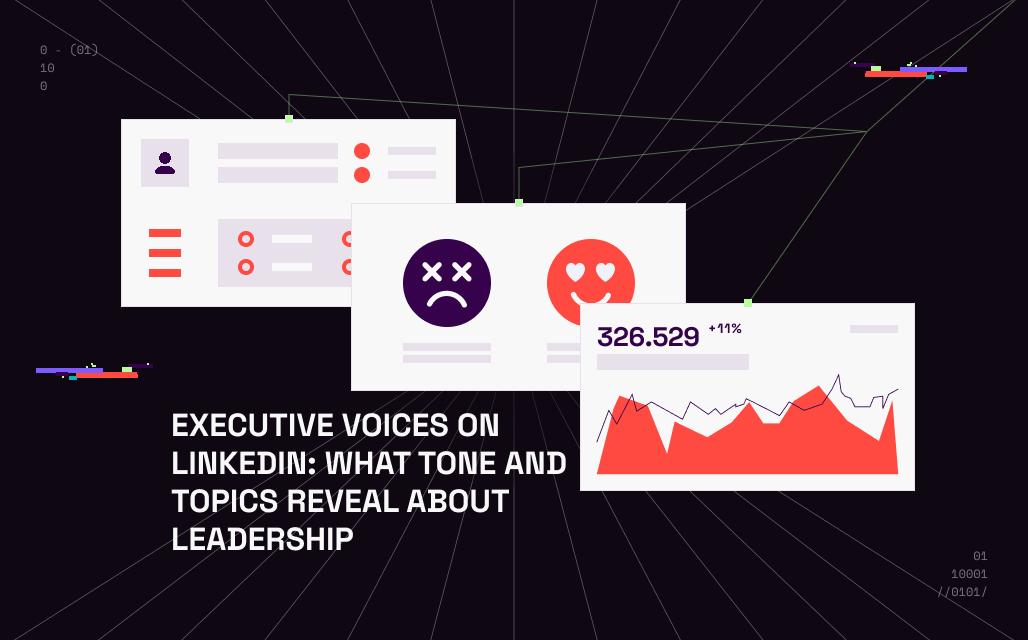LinkedIn as a mirror of leadership
Should a senior executive at a major company be active on LinkedIn? And if so, what should they say? How should they position themselves? What’s the real purpose of being on LinkedIn?
The data tells us that LinkedIn has moved beyond being a platform for self-promotion, it's now a thermometer of leadership.
After analyzing over 200 posts from top executives at Ibex35 companies and classifying them by tone and topic, clear patterns, narrative gaps, and strategic decisions emerge.
These posts come from 17 executives and were published over a 6-month period (Oct. ’24 – Mar. ’25).
But these findings aren’t a magic formula to chase likes, they’re about understanding what the communication behavior of today’s top business leaders is really telling us.
1. TONE ANALYSIS
The professional, serious, and impersonal tone is the least used.
If we take a basic look at post tone, we find that all styles generate roughly the same average engagement per post. In other words, tone (at first glance) doesn’t significantly influence audience interest.
So why all the “at first glance” disclaimers? (Yes, they’re intentional.)
Because we need to cross-reference tone with another variable -say, topic- to really uncover insights.
Looking at tone in isolation, we found that a personal tone was used most often, followed by emotional. The professional, serious, and impersonal tone ranked last in frequency.
2. TOPIC ANALYSIS
Talking about success works
Posts around professional achievements, like “expansion” or “growth”, receive better engagement than other topics. In contrast, themes like “technology” and “infrastructure” generate the least interest.
The most frequently discussed topic is “growth,” followed by “support.” And just like tone, things get more interesting when we analyze topic in relation to another dimension. So let’s dive in.
3. HERE'S THE GOOD STUFF: THE INTERSECTION BETWEEN TONE AND TOPIC.
The real power of data lies in how different dimensions intersect to reveal “hidden” and often more valuable insights.
.png)
When it comes to topics like “growth” or “sustainability,” using a professional tone drives stronger results.
For example, posts about growth are presented in an emotional tone 56% of the time. However, when they use a professional tone instead, they earn 10% more engagement on average.
Similarly, sustainability-themed posts generate double the average engagement when they’re written in a professional tone.
Of course, these insights need to be contextualized based on the company’s tone of voice, strategic goals, and core activities. For instance, if a company consistently shares sustainability-related achievements, it may see high engagement regardless of tone, even if every post uses a neutral voice.
Patterns and formulas identified
We were especially intrigued by the combination of “growth” as a topic with an emotional tone. When we explored these posts, we noticed several common traits:
- Thank-you messages
- Focus on daily team effort
- Mentions of the company’s socioeconomic role
- Use of first-person voice to express pride and satisfaction
On the other hand, the least engaging topic (“infrastructure”) actually sees better engagement when paired with a non-professional tone. Posts in this category often include:
- Site visits or infrastructure inaugurations
- Posts accompanied by photos
- First-person expressions of admiration and awe


#BONUSTRACK WHAT'S GOING ON WITH SUSTAINABILITY?
“Sustainability” accounts for nearly 10% of the total posts analyzed during the study period. Yet surprisingly, despite its recurring presence in corporate communications across the Ibex35, it only drives about 5% of total engagement.
Why is that? What’s not working?
We propose three potential hypotheses—though a more accurate analysis would require company-specific context around the topic, the product or service, the brand, and the executive’s personal communication style:
- Sustainability actions are communicated without context and with sterile corporate language.
- The topic is perceived as performative, something that’s included out of obligation.
- There’s no authentic connection to the company’s core purpose or the executive’s personal vision.
ONE LAST THOUGHT: Digital leadership isn’t improvised.
This analysis isn’t about telling CEOs how to use LinkedIn. But it does suggest that their presence (or absence) says more than they may think.
LinkedIn is no longer just a social network—it’s a global stage for leadership. And every post, every silence, every tone, and every topic adds or subtracts from a leader’s reputation, trust, and influence.
Digital leadership isn’t improvised. It’s intentional, it’s trained, and it’s planned. And to do that, we need to analyze it with precision and context.










